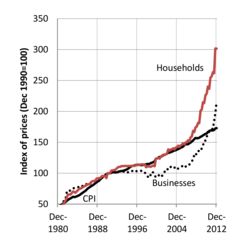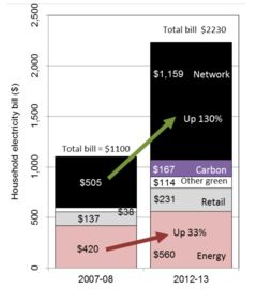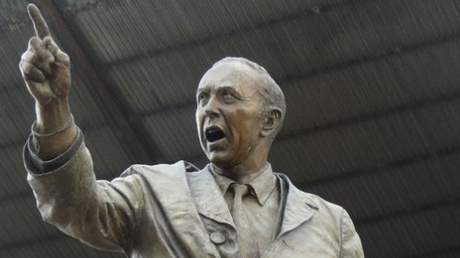According to Australian Bureau of Statistics consumer prices data – mentioned in the fine print of this Facebook update – between the December quarter of 2007 and the March quarter of 2013, Australia’s electricity price index did indeed increase by 94%.
That much is true. But while this price rise has occurred under federal Labor’s watch, there have a huge range of factors that have contributed to the sharp increase in your electricity bill – many of which have nothing to do with the federal government.
“If you think electricity is costing you more under Labor, then you’re right. Under the Rudd/Gillard Labor government, electricity prices have gone up 94%. And don’t forget: the cost will go up even more when Labor’s Carbon Tax goes up on the 1 July!” – Liberal Party of Australia on Facebook, 24 June.

Up until 2007, retail electricity prices increased at about the same rate as inflation. But from mid-2007 onwards, electricity prices have risen quite rapidly, with NSW and Victorians seeing increases of more than 100%, above the national average.
By far the largest contributor to the increasing prices over the past six years has been network costs. Network costs represent between 45% and 55% of a typical electricity bill, and it is this component has increased the most aggressively (see the graph below from the Productivity Commission). In NSW, network costs accounted for 80% of the price increase in 2010-11 and 50% of price rises in 2011-12.

According to the Australian Energy Market Commission’s latest report on electricity price trends, network costs are predicted to continue dominating electricity price increases. In fact, of the projected national price increases between now and 2014/15, virtually all is projected to be due to network costs.
Network businesses (both transmission and distribution – essentially the poles and wires) are regulated monopolies, with expenditure and prices authorised by various regulators. Over the last six years, most of these “regulatory determinations” have been authorised by state-based regulators. And those that weren’t, were authorised by the Australian Energy Regulator (AER), an independent statutory authority that the federal, state and territory governments jointly agreed to establish back in 2004.
Network price increases have thus been regulated through state-based regulators, or through the independent AER. So the federal government only has a very limited ability to influence prices in this significant area.
Retail costs increasingly are market-driven, and those that are regulated, are regulated at a state level. “Green schemes” are either state-based or enjoy bipartisan national support, like the Renewable Energy Target, which was introduced by the Howard government and then expanded to a 20% target by the Rudd government. Currently, state-based green energy schemes add about 1% to an average household power bill, while the federal schemes including the Renewable Energy Target add another 3%.
The carbon price is something that can be attributed solely to the federal government. So how much would removing the carbon price lower electricity prices?
As discussed in an earlier fact check, a reasonable answer would be by around 5%, with an upper boundary of about 10%.
Verdict
Technically true, though it is wrong to imply that the federal Labor government has been responsible. Most of that rise has been due to much higher network charges, which are set by state-based regulators or by the independent Australian Energy Regulator.
Review
The key findings – that electricity prices have increased by the amount claimed, but that most of this increase cannot be attributed to the Australian government – are correct.
Indeed, the energy market framework was developed between 1991 and 1998, and the Howard government commissioned a review by former energy minister Warwick Parer in 2002. So the rules that have shaped the outcomes of the electricity market were framed under both Labor and Coalition governments, with the Coalition being in power when the market began, and in its early years of development.
It is also correct that decisions regarding network charges were made by state and independent national regulators. In recent years, the Queensland and NSW governments have clearly used inflated revenue from electricity networks to fund government services instead of either increasing other taxes or cutting services. The recent Senate Inquiry into Electricity Pricing found that the network charges from state-owned networks were around 30% higher than those of privately-owned networks. This confirms the key role of the state governments that still own electricity networks in driving price increases.
One of the claims made to justify energy market reform was that it would reduce government intervention in the electricity sector. Further, the responsibility for energy reform was allocated by the Council of Australian Governments (COAG) to the Ministerial Council on Energy, which was recently renamed the Standing Council on Energy and Resources. This body includes representatives from all states and territories as well as the Commonwealth.
While network costs have been the major driver of cost increases in most states, in Victoria, increases in retailer charges to cover customer acquisition costs have been more significant. This has been confirmed by a recent report from the Essential Service Commission (the Victorian regulator). Retailer licensing is still a state level issue. – Alan Pears, Adjunct Professor, School of Global Studies, Urban and Sociak Studies, RMIT University




